industries commonly use rigid flex PCBs
Rigid Flex PCBs are an ideal solution for a range of industries. They provide superior performance in demanding environments and enable product miniaturization without sacrificing durability or reliability. Rigid flex circuit boards are commonly used in consumer electronics, aerospace and defense equipment, industrial automation systems, medical devices, automotive electronic components, and other specialized applications that require both rigidity and flexibility.
Rigid flex PCBs consist of rigid sections of FR-4 or high-reliability materials and flexible circuits that are bound together with an epoxy or polyimide film called a cover lay. Conductive copper layers are etched on both sides of the layer stack, and through holes are drilled to interconnect the rigid and flexible sections of the circuit board. Finally, the copper traces are plated and the layers are coated with a solder mask to protect them from corrosion, outgassing, and other contaminants.

Choosing a manufacturer that specializes in rigid flex pcb can make the design and manufacturing process much smoother. Dedicated teams with extensive experience with this technology have an intimate understanding of its unique challenges and requirements. They will be able to optimize the rigid-flex layout to achieve your project’s desired structural, electrical, and mechanical performance.
What types of industries commonly use rigid flex PCBs?
The rigid-flex construction provides the stability and robustness required for a range of environmental conditions, including varying temperatures and vibration. Using finite element analysis (FEA) and other engineering techniques, manufacturers can optimize structural aspects of the circuit to prevent flex fatigue or signal loss due to vibration. They can also help ensure that the combination of rigid and flex sections maintains structural integrity throughout the lifespan of the device by incorporating thermal vias, heat sinks, or other cooling techniques into the design.
In addition to ensuring that rigid-flex PCBs perform properly under various environmental conditions, manufacturers need to make sure that they adhere to strict quality standards. Rigid-flex PCBs often have complex layer structures, requiring careful and precise fabrication to avoid errors that could impact product functionality and reliability. This is especially important with the use of exotic materials that may be susceptible to oxidation, stress cracking, or outgassing.
When choosing a manufacturer for rigid-flex PCBs, look for one that offers a wide range of manufacturing capabilities to ensure your product is made correctly and quickly. They should be able to handle the demands of any complex rigid-flex PCB layout, including high-density, multilayer designs.
They should also have the ability to offer advanced fabrication processes like laser ablation and controlled depth milling, which can help reduce costs by minimizing waste and improving process control. Finally, look for a manufacturer with a solid track record of meeting deadlines, as this can be a crucial factor in bringing your product to market on time. The right manufacturer can deliver exceptional results that will give your business a competitive edge.
